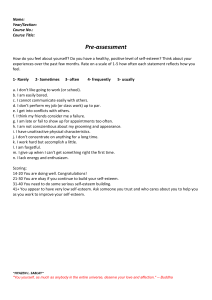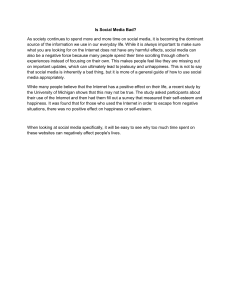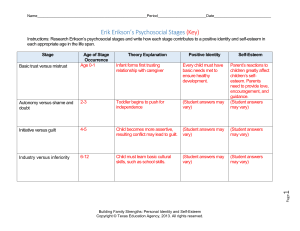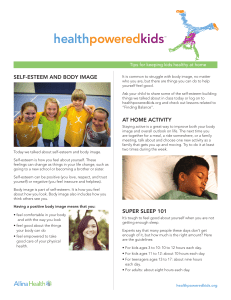fpsyt-10-00698 Low self esteem association with anxiey in viet students
advertisement
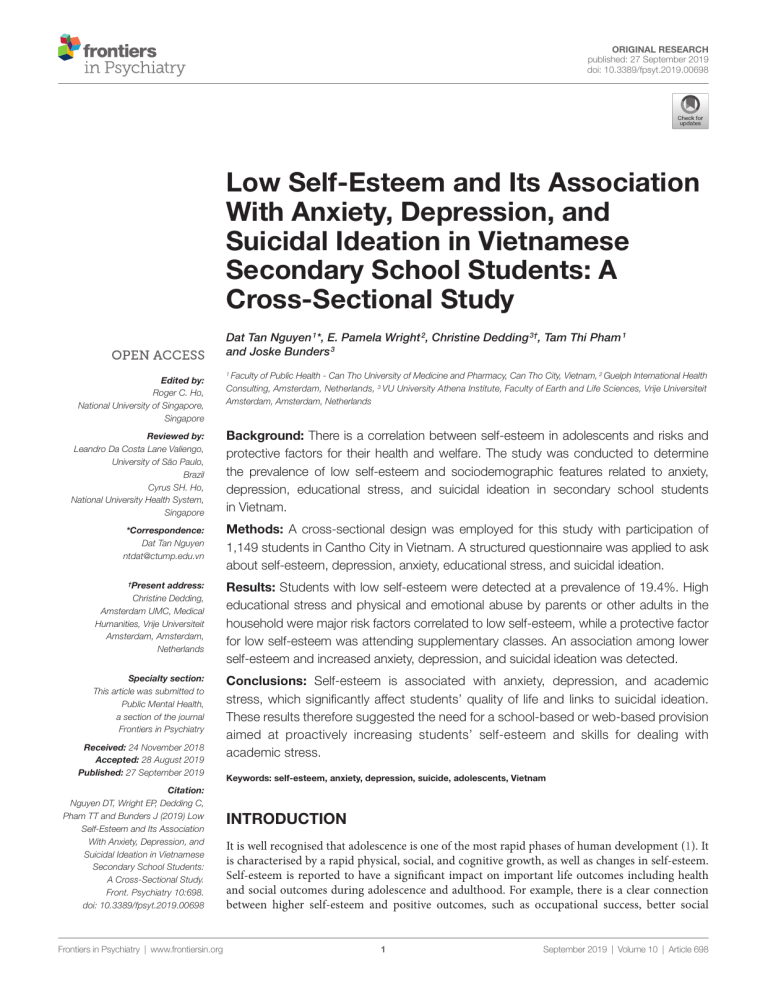
ORIGINAL RESEARCH published: 27 September 2019 doi: 10.3389/fpsyt.2019.00698 Low Self-Esteem and Its Association With Anxiety, Depression, and Suicidal Ideation in Vietnamese Secondary School Students: A Cross-Sectional Study Dat Tan Nguyen 1*, E. Pamela Wright 2, Christine Dedding 3†, Tam Thi Pham 1 and Joske Bunders 3 Edited by: Roger C. Ho, National University of Singapore, Singapore Faculty of Public Health - Can Tho University of Medicine and Pharmacy, Can Tho City, Vietnam, 2 Guelph International Health Consulting, Amsterdam, Netherlands, 3 VU University Athena Institute, Faculty of Earth and Life Sciences, Vrije Universiteit Amsterdam, Amsterdam, Netherlands 1 Reviewed by: Leandro Da Costa Lane Valiengo, University of São Paulo, Brazil Cyrus SH. Ho, National University Health System, Singapore Background: There is a correlation between self-esteem in adolescents and risks and protective factors for their health and welfare. The study was conducted to determine the prevalence of low self-esteem and sociodemographic features related to anxiety, depression, educational stress, and suicidal ideation in secondary school students in Vietnam. *Correspondence: Dat Tan Nguyen ntdat@ctump.edu.vn Methods: A cross-sectional design was employed for this study with participation of 1,149 students in Cantho City in Vietnam. A structured questionnaire was applied to ask about self-esteem, depression, anxiety, educational stress, and suicidal ideation. Present address: Christine Dedding, Amsterdam UMC, Medical Humanities, Vrije Universiteit Amsterdam, Amsterdam, Netherlands Results: Students with low self-esteem were detected at a prevalence of 19.4%. High educational stress and physical and emotional abuse by parents or other adults in the household were major risk factors correlated to low self-esteem, while a protective factor for low self-esteem was attending supplementary classes. An association among lower self-esteem and increased anxiety, depression, and suicidal ideation was detected. Specialty section: This article was submitted to Public Mental Health, a section of the journal Frontiers in Psychiatry Conclusions: Self-esteem is associated with anxiety, depression, and academic stress, which significantly affect students’ quality of life and links to suicidal ideation. These results therefore suggested the need for a school-based or web-based provision aimed at proactively increasing students’ self-esteem and skills for dealing with academic stress. † Received: 24 November 2018 Accepted: 28 August 2019 Published: 27 September 2019 Citation: Nguyen DT, Wright EP, Dedding C, Pham TT and Bunders J (2019) Low Self-Esteem and Its Association With Anxiety, Depression, and Suicidal Ideation in Vietnamese Secondary School Students: A Cross-Sectional Study. Front. Psychiatry 10:698. doi: 10.3389/fpsyt.2019.00698 Frontiers in Psychiatry | www.frontiersin.org Keywords: self-esteem, anxiety, depression, suicide, adolescents, Vietnam INTRODUCTION It is well recognised that adolescence is one of the most rapid phases of human development (1). It is characterised by a rapid physical, social, and cognitive growth, as well as changes in self-esteem. Self-esteem is reported to have a significant impact on important life outcomes including health and social outcomes during adolescence and adulthood. For example, there is a clear connection between higher self-esteem and positive outcomes, such as occupational success, better social 1 September 2019 | Volume 10 | Article 698 Nguyen et al. Low Self-Esteem in Vietnamese Students MATERIALS AND METHODS relationships, a sense of well-being, and positive perceptions by peers, academic achievement, and good coping skills (2, 3). Low self-esteem is causally related to depression, substance abuse, antisocial behaviour, and suicide (4–6). The literature demonstrates that social functioning, such as acceptance by peers, is lower in children with low self-esteem (7). Extensive research has explored risk and protective factors related to low self-esteem development during adolescence. Reported risk factors include being a girl (6, 8, 9), the family’s low socioeconomic status (10), parents’ education level, family eligibility for public assistance, eligibility for free or reduced-cost school meals, the parents’ employment status (11), and school performance and grades (6, 12), as well as obesity (13). Academic achievement is known to be affected by self-esteem, while self-esteem may also influence academic achievement (7). High self-esteem is reported as an important predictive factor for students’ academic achievement (14). Another study found that while high self-esteem resulted in many positive outcomes and benefits, it did not necessarily lead to good school performance (15). On the other hand, adolescents with poor academic results did not always have low general self-esteem (16). There is an association between low self-esteem and negative outcomes for young people’s behavioural and mental health problems, including health-compromising behaviours such as substance abuse, early sexual activity, and eating problems (17). A longitudinal study among a large sample of young New Zealanders found, however, that while low self-esteem significantly predicted adolescent eating and other healthcompromising behaviours, it was not related to substance abuse and early sexual activity (18). With regard to mental health, a correlation has been detected between low self-esteem and depression (19, 20), anxiety (10, 21), and adolescents’ suicidal ideation and attempts (18, 22). Reports during the past few years indicate that there is a strong relationship between academic pressure and stress, depression, anxiety, low self-esteem, and suicidal ideation among students in secondary or high school and in young adults (23–25). A study describing perceptions about mental illness in Hue in Vietnam noted that “studying or thinking too much” is a cause of mental health problems (26). In Vietnamese culture, the pressure from parents and schools might be expected to have an unintended effect, leading to lower self-esteem and associated outcomes seen elsewhere among high school students. There are as yet no reports of systematic studies on this issue in Vietnam, and there are few reports of descriptive or analytical research into adolescent self-esteem. This is particularly relevant since we found high levels of depression, anxiety, and suicidal ideation among secondary school students in Vietnam [Nguyen, D. T., Dedding, C., Pham, T. T., Wright, P., & Bunders, J. (25)]. This article reports on a study that aimed to determine (1) the prevalence of low self-esteem; (2) the characteristics associated with low selfesteem; and (3) the relationships among self-esteem and anxiety, depression, educational stress, and suicidal ideation in secondary school students. We hypothesised that low selfesteem would be associated with a greater risk of poor mental health status. Frontiers in Psychiatry | www.frontiersin.org Study Design and Participants A cross-sectional study design was used to recruit 1,260 students at three secondary schools in urban and suburban areas in Cantho City in Vietnam. All data were collected during the first academic semester, from September to December 2011. A more detailed description of the sampling and its participants can be found elsewhere (25). Measures All participants were invited to provide information by selfreporting using a questionnaire. This was done after class or at home anonymously to minimise potential reporting bias and to keep information confidential. The detailed components of the questionnaire have been described elsewhere (25). The 10-item Rosenberg Self-esteem Scale (21, 27) was used to assess global self-esteem, with higher scores indicating more positive self-regard. Each item asked for response using a 4-point Likert scale ranging from 1 (strongly agree) to 4 (strongly disagree). The scale is generally reliable, with test–retest correlations value between 0.82 and 0.88 (21). The Cronbach α of the scale in the present study was 0.77. The scale ranges from 0 to 30: a score greater than 25 suggests high self-esteem; scores between 15 and 25 are considered to be within normal range, whereas scores less than 15 suggest low self-esteem (Morris Rosenberg). A more detailed method description on employing the Center for Epidemiology Studies Depression (CES-D), the anxiety scale, and the Educational Stress Scale for Adolescents for this study is available (25). To address the issue of suicidal ideation, additional questions on whether the student had ever seriously considered suicide or made a suicide plan used a 3-point scale (never, sometimes, and often). A yes/no question was also used to identify students who had attempted suicide. To define risks and protective factors, we explore the variables listed in Table 1, including mother’s education, physical and emotional abuse by parents or other adults in the household or school, academic performance in the last semester, educational stress, attendance at a supplementary class, and use of personal tutor. The data collected using the questionnaire is available in the Supplementary Data File. Data Analysis Demographic data were analysed descriptively to determine basic characteristics of the sample population and presented as means ± standard deviations (SD). The χ2 test was used to assess the significance of differences in the distribution of participants by selected sociodemographic characteristics, risk factors, and outcome variables. Associations between low self-esteem and family characteristics, educational stress, and academic achievement were explored by logistic regression analysis. Univariate independent predictors of low self-esteem with p < 0.10 were entered in a multivariate logistic regression model, and the backward Wald method was applied to study their influence on the presence of low self-esteem. Univariate logistical analyses were also applied to determine the relationships among low self-esteem and 2 September 2019 | Volume 10 | Article 698 Nguyen et al. Low Self-Esteem in Vietnamese Students TABLE 1 | Frequencies and percentages (%) of sociodemographic variables of participants by self-esteem status. Total n Total screened Age, mean (SD) Sex Male Female Family economic status Comfortable living and wealthy Very poor/poor/earn just enough to live Academic performance in the last semester Excellent/good Fairly good/average Below average/very poor Personal tutor Yes No Attendance at supplementary class None One or more Mother’s education > Primary school <= Primary school 1,149 Low self-esteem % N 100 223 16.05 419 730 1,148 664 484 1,130 225 854 51 1,142 928 214 1,146 323 823 1,143 1,006 137 Normal self-esteem % n 19.4 926 16.01 223 72 151 222 100 122 219 33 168 18 223 166 57 223 81 142 222 181 41 36.5 63.5 57.8 42.2 19.9 75.6 4.5 81.3 18.7 28.2 71.8 88.0 12.0 pa % 80.6 16.05 32.3 67.7 45,0 55.0 15.1 76.7 8.2 74.4 25.6 36.3 63.7 81.5 18.5 926 347 579 926 564 362 911 192 686 33 919 762 157 923 242 681 921 825 96 0.290 0.085 37.5 62.5 <0.001 60,9 39.1 0.003 21.1 75.3 3.6 0.004 82.9 17.1 0.003 26.2 73.8 0.001 89.6 10.4 χ was used to compare differences in percentages; t test was used to compare differences in means. a 2 anxiety, depression, and suicidal ideation, and Pearson correlation coefficients were used to measure the correlations among these. All analyses were carried out using a significance level of 5%, and all tests were 2-sided. The 95% confidence intervals (CIs) of odds ratios (ORs) were also calculated. All analyses were analysed by using SPSS Inc, Chicago, the United States of America version 16.0. logistic regression analysis, among six investigated variables, two variables “having a personal tutor” and “attendance at supplementary class” were negatively associated with the risk of low self-esteem, while the other variables were positively correlated to low self-esteem (Table 2). Students were likely to show lower self-esteem, when their mother’s education was at primary level or below, when they were often physically or emotionally abused at home or at school, when they had below average/very poor academic performance in the last semester, or when they reported experiencing high educational stress. In the multivariate regression analysis (with the backward Wald method), not accounting for effect modification, four variables remained correlated to low self-esteem, either in a negative or positive direction. Having a personal tutor and academic performance in the last semester were no longer a significant association, but attending supplementary classes still remained a protective factor for low self-esteem (reduced OR of 43% compared with students not attending) (Table 2).Study results that were considerably positively associated to low self-esteem were medium and high educational stress (ORs = 2.25 and 4.02, respectively). RESULTS Demographics Of the 1,260 students invited to participate, 111 (7.3%) were excluded from analysis because they did not adequately complete the questionnaire; for example, they did not provide answers to five or more items in the CES-D. The final sample comprised 1,149 senior high school students with a mean age of 16.1 years. Participating students were fairly evenly distributed in terms of sex: 36.5% males and 63.5% females (Table 1). This proportion also reflects the proportion of males and females enrolled in the classes studied. Students’ participation from each grade (10–12) did not significantly differ, at around 33% each. Ninety-five percent of students were ethnically Kinh; other ethnic groups included Hoa and Khmer. This sample was in line with the school population in this area. Relationships Between Self-Esteem and Anxiety, Depression, and Educational Stress, and Suicidal Ideation Prevalence of Low Self-Esteem and Characteristics Associated With Self-Esteem As shown in Table 3, four variables—self-esteem, anxiety, depression, and educational stress—were related to each other. Self-esteem was negatively correlated to anxiety, depression, and educational stress, while educational stress was positively correlated to anxiety and depression. One of the purposes of the study was to identify the impact of selfesteem on mental health problems. The results of univariate logistics The mean self-esteem score was 17.56 on a scale of 0 to 30. The scores for boys and girls were similar (17.83 vs. 17.40; t = 1.720; p = 0.086). Based on all scores, nearly a fifth (19.4%) of the respondents reported low self-esteem according to Rosenberg’s criteria, with scores below 15 (Table 1). Based on univariate Frontiers in Psychiatry | www.frontiersin.org 3 September 2019 | Volume 10 | Article 698 Nguyen et al. Low Self-Esteem in Vietnamese Students TABLE 2 | Factors associated with low self-esteem: multivariate logistic regression analyses. Factors Low self-esteem n (%) Normal self-esteem n (%) Univariate logistic regression OR (95% CI) Mother’s education (n = 1,143) > Primary school 181 (18.0) 825 (82.0) Reference ≤ Primary school 41 (29.9) 96 (90.1) 1.95 (1.31–2.90) Physical and emotional abuse by parents or other adults in the household (n = 1,146) No 192 (18.5) 845 (81.5) Reference Yes 31 (28.4) 78 (71.6) 1.75 (1.12–2.73) Academic performance in the last semester (n = 1,130) Excellent/good 33 (14.7) 192 (85.3) Reference Fairly good/average 168 (19.7) 686 (80.3) 1.43 (0.95–2.14) Below average/very poor 18 (35.5) 33 (64.7) 3.17 (1.60–6.28) Educational stress (n = 1,142) Low stress 31 (9.4) 300 (90.6) Reference Medium stress 68 (17.4) 322 (82.6) 2.04 (1.30–3.22) High stress 121 (28.7) 300 (71.3) 3.90 (2.55–5.98) Personal tutor (n = 1,142) Yes 166 (17.9) 762 (82.1) Reference No 57 (26.6) 157 (73.4) 1,67 (1,18–2,36) Attendance at supplementary class (n = 1,146) None 81 (25.1) 242 (74.9) Reference One or more 142 (17.3) 681 (82.7) 0.62 (0.46–0.85) Total (n = 1149) 223 (19.4) 926 (80.6) Multivariate logistic regression p-value OR (95% CI) p-value – 0.001 Reference 1.68 (1.09–2.69) – 0.018 – 0.013 Reference 1.76 (1.10–2.82) – 0.018 – 0.087 0.001 Reference – – – – – – 0.002 <0.001 Reference 2.25 (1.41–3.58) 4.02 (2.60–6.23) – 0.001 <0.001 – 0,004 – – – – – 0.003 Reference 0.57 (0.41–0.79) – 0.001 Significance levels were at the 0.05 level (2-tailed). had low self-esteem, with no difference between girls and boys. These results are in line with some previous studies (12, 28), but inconsistent with others (6, 12). Cultural and social differences in the study populations could explain some of the differences. TABLE 3 | Pearson correlations between self-esteem, anxiety, depression, and educational stress. Self-esteem Anxiety Depression Educational stress Self-esteem Anxiety Depression – −0.219 −0.426 −0.249 – 0.422 0.318 – 0.308 Educational stress Reasons for Having a Higher Prevalence of Low Self-Esteem Among Females – The results of this study cannot provide precise reasons for the higher prevalence of lower self-esteem among females; however, a number of possible causes for the gender differences are worth discussing. Although gender equality has improved in recent years in Vietnam and is clearly legislated, gender issues within the family and society remain a challenge for most Vietnamese, who are strongly influenced by traditional culture and custom (29). There is an association between female gender and emotionally unstable personality (30, 31). As a result, women are more prone to develop emotionally unstable personality (e.g. borderline personality) (32). Thus, females’ self-esteem may be more likely to fluctuate, depending on how they themselves or others, especially their parents, evaluate their achievements. A high prevalence of low self-esteem among the secondary school students should be considered as an important mental health problem not only by parents, school teachers, and principals but also by policy makers in the education and health sectors in Vietnam. In fact, health care related to psychological disorders has not received adequate consideration yet in Vietnam (33). Therefore, it is important to take mental health care into account when developing a policy framework to improve general school health services, such as directive no. 23/2006/CT-TTg on having wellequipped and professionally qualified health officers in schools (34), and Decision No. 401/2009/QD-TTg, which approved the All correlations are significant at the 0.001 level (2-tailed). indicate that low self-esteem contributed significantly to anxiety, depression, and suicide among adolescents. Compared to students who reported normal self-esteem, the students who reported low self-esteem had twice the odds of having anxiety symptoms [20.3% (187/921) vs. 34.2% (76/222)] (OR = 2.04; 95% CI OR = 1.48–2.82, p < 0.001), nearly six times the odds of being at risk of depression (CES-D score of ≥16) (74.0% vs. 33.2%), (OR = 5.72; 95% CI OR = 4.11–7.59), four times the odds of having depressive symptoms (CES-D scores of > 21) (50.7% vs. 19.8%) (OR = 4.16; 95% CI OR = 3.06–5.66), and nearly five times the odds of having depression (CES-D score of > 25) (41.7% vs. 13.0%), (OR = 4.79; 95% CI OR = 3.45 – 6.65). Students with low self-esteem also were significantly more likely to have considered or attempted suicide (Table 4). DISCUSSION We investigated the prevalence of low self-esteem among secondary school students, the characteristics associated with low self-esteem, and the relationships among self-esteem and anxiety, depression, and suicide. Nearly 20% of the students Frontiers in Psychiatry | www.frontiersin.org 4 September 2019 | Volume 10 | Article 698 Nguyen et al. Low Self-Esteem in Vietnamese Students TABLE 4 | Associations between self-esteem and suicidal ideation. Seriously considered suicide Normal self-esteem Low self-esteem Planning suicide Normal self-esteem Low self-esteem Attempted suicide Normal self-esteem Low self-esteem Yes n (%) No n (%) 301 (26.3) 213 (23.1) 88 (39.6) 142 (12.8) 96 (10.8) 46 (21.0) 44 (3.9) 28 (3.1) 16 (7.3) 844 (73.7) 710 (76.9) 134 (60.4) 965 (87.2) 792 (89.2) 173 (79.0) 1,095 (96.1) 884 (96.9) 204 (92.7) OR (CI 95%) p – 2.19 (1.61–2.98) – <0.001 – 2.19 (1.49–3.23) – <0.001 – 2.48 (1.32–4.66) – 0.004 Significance levels were at the 0.05 level (2-tailed). program “Preventing and combatting diseases in educational establishments belonging to the national education system” (35). Our results confirm the findings of previous studies (6, 10, 25, 36), namely, that family characteristics, including mother’s low educational level and physical and emotional abuse by parents or other adults in the household, were associated with low levels of self-esteem. In addition, educational characteristics such as the school environment, academic performance, and high educational stress were strongly associated with self-esteem. These findings are consistent with results of other studies, for example, by Pullmann & Allik (16), which found that parents have a great deal of influence on their children’s psychological development, including on the relationships outside the family environment (6, 10). Students who attended one or more supplementary classes appeared to be at lower risk of having poor self-esteem. In Vietnam, these students are usually from a family with a higher socioeconomic status. Attending supplementary class may reduce the stress of workload and academic pressure for those students. It would be useful to confirm this with further studies in the Vietnamese context, but this kind of support is unlikely to be available to families who cannot pay for it. Low self-esteem in the adolescents in Cantho City was associated with poor academic performance. Aryana (14) reported that high self-esteem among preuniversity students was an important factor in predicting high academic achievement. Our finding also highlights that self-esteem plays an important role in predicting academic achievement, although a cross-sectional study design is unable to demonstrate causality; a prospective study to identify causality of the low self-esteem would be appropriate in future research. With regard to mental health, the results of Pearson correlation analysis showed that self-esteem was negatively correlated to anxiety, depression, and educational stress, while the results of univariate logistic regression illustrated that low self-esteem contributed to a high risk of anxiety, depression, and suicidal ideation. These results are comparable to others showing that low self-esteem was associated with depression (19, 20, 37) and identifying a relationship between self-esteem and anxiety (10, 21), as well as a relationship between low self-esteem and suicidal ideation and suicide attempts among adolescents (18, 22). Screening for low self-esteem in adolescents is a possible strategy to help identify secondary school students at risk of anxiety, depression, and suicide. In addition, our previous study (25) showed an association between mental health problems and academic pressure, resulting from an overloaded curriculum Frontiers in Psychiatry | www.frontiersin.org and pressure from teachers and parents to succeed. There is clearly a need to reduce mental health problems among today’s secondary school students in Vietnam. The development of a website to provide psychoeducation designed to meet the needs of young Vietnamese and of school-based counselling services for students, possibly by collaborating with volunteers from the Youth Union, the largest sociopolitical Vietnamese youth organization, at local universities, teachers, and parents, will be explored as one of the solutions (36). Around 66.3% of young Vietnamese downloaded the mobile health applications for disease prevention (38). Nevertheless, one of the challenges to using a digital health intervention is that young Vietnamese with a higher perceived stress level were significantly less likely to use such interventions (39). Study Limitations One limitation of this study relates to the sample and its generalizability. Although the distribution of girls and boys reflected the true/current situation in the classes selected, the sample was from only three schools in urban and suburban Cantho. Another limitation concerns the study design, which specified collection of data from adolescents by self-reporting using standardised questionnaires. The respondents’ personality and identity development are still incomplete, which could result in fluctuating self-perceptions (9) and thus unreliable reporting. Also, the exploration of potential causes of low self-esteem as self-reported by subjects was not included in the survey. Another limitation is that the cross-sectional study design does not permit detection of links between covariates; longitudinal studies on this topic are still needed. Finally, the self-esteem, anxiety, and CES-D scales, like other screening instruments, cannot be viewed as diagnostic tools, but only as screening tests to identify members of groups at risk for these conditions. The results tell us how the students perceive their health but are not in themselves evidence of medical concerns. Moreover, there is no assessment of stress coping and stress levels, obesity (40), and chronic medical illness (e.g. asthma) (41), which may confound and influence anxiety, depression, and suicidal ideations. Finally, in a cross-sectional study, the cause–effect relationship cannot be measured; that requires a longitudinal cohort or a randomised controlled study. 5 September 2019 | Volume 10 | Article 698 Nguyen et al. Low Self-Esteem in Vietnamese Students CONCLUSIONS FUNDING Our research suggested that self-esteem is correlated to anxiety, depression, and academic stress, which significantly affects students’ quality of life and is linked to suicidal ideation. The results therefore suggest the need for a school-based or web-based provision of information or services aimed at proactively increasing students’ self-esteem and skills for dealing with academic stress. The study has been supported by a scholarship from the “Strengthening teaching and research capacity of preventive medicine staffs to meet the challenges of emerging infections and new environmental hazards to health” Project, collaboration between Hanoi University, NUFFIC, and the Dutch Government. ETHICS STATEMENT ACKNOWLEDGMENTS The study was approved by the Scientific and Training Committees of Cantho University of Medicine and Pharmacy. Written informed consent for participation was obtained from students’ parents or legal guardians before data collection. Special thanks to all the students who participated in the study. We would also like to thank Hanoi University of Medicine and Cantho University of Medicine and Pharmacy as the Coordinating Board of the project in Vietnam and Professor Pham Van Linh, Rector of Cantho University of Medicine and Pharmacy, for their kind support for this work. Our appreciation also goes to Professor Wim Brandsma and Professor Wim van Brakel for their kind advice on the data analysis. AUTHOR CONTRIBUTIONS A first draft of the manuscript was prepared by DN under the guidance of CD. All authors contributed to the final manuscript version. DN, JB, and CD jointly generated the research idea and the study design. DN, CD, TP, and EW contributed to the survey tools. DN and TP coordinated the surveys and data collection in the field. DN, TP, CD, and EW carried out data analysis. SUPPLEMENTARY MATERIAL The Supplementary Material for this article can be found online at: https://www.frontiersin.org/articles/10.3389/fpsyt.2019.00698/ full#supplementary-material REFERENCES 11. Berg PVD, Mond J, Eisenberg M, Ackard D, Neumark-Sztainer D. The link between body dissatisfaction and self-esteem in adolescents: similarities across gender, age, weight status, race/ethnicity, and socioeconomic status. J Adolesc Health (2010) 47:290–6. doi: 10.1016/j. jadohealth.2010.02.004 12. Birndorf S, Ryan S, Auinger P, Aten M. High self-esteem among adolescents: longitudinal trends, sex differences, and protective factors. J Adolesc Health (2005) 37(3):194–201. doi: 10.1016/j.jadohealth.2004.08.012 13. Mak KK, Pang JS, Lai CM, Ho RC. Body esteem in Chinese adolescents: effect of gender, age, and weight. J Health Psychol (2013) 18(1):46–54. doi: 10.1177/1359105312437264 14. Aryana M. Relationship between self-esteem and academic achievement amongst pre-university students. J Appl Sci (2010) 10(20): 2474–7. doi: 10.3923/jas.2010.2474.2477 15. Baumeister RF, Campbell JD, Krueger JI, Vohs KD. Does high self-esteem cause better performance, interpersonal success, happiness, or health lifestyles? Psychol Sci Public Interest (2003) 4(1):1–44. doi: 10.1111/1529-1006.01431 16. Pullmann H, Allik J. Relations of academic and general self-esteem to school achievement. Pers Individual Diff (2008) 45:559–64. doi: 10.1016/j. paid.2008.06.017 17. Keane L, Loades M. Review: low self-esteem and internalizing disorders in young people—a systematic review. Child Adolesc Mental Health (2017) 22(1):4–15. doi: 10.1111/camh.12204 18. McGee R, Williams S. Does low self-esteem predict health compromising behaviours among adolescents? J Adolesc (2000) 23:569–82. doi: 10.1006/ jado.2000.0344 19. Millings A, Buck R, Montgomery A, Spears M, Stallard P. School connectedness, peer attachment, and self-esteem as predictors of adolescent depression. J Adolesc (2012) 35:1061–7. doi: 10.1016/j. adolescence.2012.02.015 20. Weber S, Puskar KR, Puskar KR. Relationships between depressive symptoms and perceived social support, self-esteem, & optimism in a sample of rural adolescents. Issues Mental Health Nursing (2010) 31:584–8. doi: 10.3109/01612841003775061 1. World Health Organization. Maternal, newborn, child and adolescent health: adolescent development. Retrieved 29/07, 2019, from https:// w w w. w ho. i nt / mate r na l _ ch i l d _ a d ol e s c e nt / topi c s / a d ol e s c e nc e / development/en/. 2. Boden JM, Fergusson DM, Horwood LJ. Does adolescent self-esteem predict later life outcomes? A test of the causal role of self-esteem. Dev Psychopathol (2008) 20(1):319–39. doi: 10.1017/S0954579408000151 3. Trzesniewski KH, Donnellan MB, Robins RW. Stability of self-esteem across the life span. J Pers Soc Psychol (2003) 84(1):205–20. doi: 10.1037//0022-3514.84.1.205 4. Choo CC, Harris KM, Chew PKH, Ho RC. What predicts medical lethality of suicide attempts in Asian youths? Asian J Psychiatr (2017) 29: 136–41. doi: 10.1016/j.ajp.2017.05.008 5. Crocker J, Wolfe CT. Contingencies of self-worth. Psychol Rev (2001) 108(3):593–623. doi: 10.1037//0033-295X.108.3.593 6. McClure AC, Tanski SE, Kingsbury J, Gerrard M, Sargent JD. Characteristics associated with low self-esteem among US adolescents. Acad Pediatr (2010) 10:238–44. doi: 10.1016/j.acap.2010.03.007 7. Bos AER, Muris P, Mulkens S, Schaalma HP. Changing self-esteem in children and adolescents: a roadmap for future interventions. Netherlands J Psychol (2006) 62:26–33. doi: 10.1007/BF03061048 8. Kling KC, Hyde JS, Showers CJ, Buswell BN. Gender differences in self-esteem: a meta-analysis. Psychol Bull (1999) 125(4):470–500. doi: 10.1037//0033-2909.125.4.470 9. Schraml K, Perski A, Grossi G, Simonsson-Sarnecki M. Stress symptoms among adolescents: the role of subjective psychosocial conditions, lifestyle, and self-esteem. J Adolesc (2011) 34:987–96. doi: 10.1016/j. adolescence.2010.11.010 10. Veselska Z, Geckova AM, Gajdosova B, Orosova O, Dijk JPV, Reijneveld SA. Socio-economic differences in self-esteem of adolescents influenced by personality, mental health and social support. Eur J Public Health (2009) 20(6):647–52. doi: 10.1093/eurpub/ckp210 Frontiers in Psychiatry | www.frontiersin.org 6 September 2019 | Volume 10 | Article 698 Nguyen et al. Low Self-Esteem in Vietnamese Students 21. Rosenberg M, Schooler C, Schoenbach C, Rosenberg F. Global self-esteem and specific self-esteem: different concepts, different outcomes. Am Sociol Rev (1995) 60(1):141–56. doi: 10.2307/2096350 22. Wild LG, Flisher AJ, Lombard C. Suicidal ideation and attempts in adolescents: associations with depression and six domains of self-esteem. J Adolesc (2004) 27:611–24. doi: 10.1016/j.adolescence.2004.03.001 23. Ghatol SD. Academic stress among higher secondary school students: a review. Int J Adv Res Educ Technol (IJARET) (2017) 4(1):38–41. 24. Kumari R, Gartia R. Relationship between stress and academic achievement of senior secondary school students. Asian J Multidimension Res (2012) 1(3):153–60. 25. Nguyen DT, Dedding C, Pham TT, Wright P, Bunders J. Depression, anxiety, and suicidal ideation among Vietnamese secondary school students and proposed solutions: a cross-sectional study. BMC Public Health (2013b) 13(1195). doi: 10.1186/1471-2458-13-1195 26. van der Ham L, Wright P, Van TV, Doan VD, Broerse JE. Perceptions of mental health and help-seeking behavior in an urban community in Vietnam: an explorative study. Community Ment Health J (2011) 47(5):574– 82. doi: 10.1007/s10597-011-9393-x 27. Rosenberg, M. Society and the adolescent self-image. Revised edition. Middletown, CT: Wesleyan University Press (1989). 28. Heinonen K, Räikkönen K, Keltikangas-Järvinen L. Self-esteem in early and late adolescence predicts dispositional optimism–pessimism in adulthood: a 21-year longitudinal study. Pers Individual Diff (2005) 39:511–21. doi: 10.1016/j.paid.2005.01.026 29. UNICEF Viet Nam. (2010). An analysis of the situation of children in Vietnam 2010. Retrieved 21/9, 2018, from https://www.unicef.org/sitan/ files/SitAn-Viet_Nam_2010_Eng.pdf. 30. Dedovic K, Wadiwalla M, Engert V, Pruessner JC. The role of sex and gender socialization in stress reactivity. Dev Psychol (2009) 45(1):45–55. doi: 10.1037/a0014433 31. Rudolph KD. Gender differences in emotional responses to interpersonal stress during adolescence. J Adolesc Health (2002) 30(4 Suppl):3–13. doi: 10.1016/S1054-139X(01)00383-4 32. Keng SL, Lee Y, Drabu S, Hong RY, Chee CYI, Ho CSH, et al. Construct validity of the McLean Screening Instrument for Borderline Personality Disorder in two Singaporean samples. J Pers Disord (2018), 30 (44):450-569. doi: 10.1521/pedi_2018_32_352 33. Communist Party of Vietnam. (2017). No. 20-NQ/TW: resolution of the sixth plenary session the 12th Party Central Committee on the protection, care and improvement of people’s health in the new situation. Retrieved March 29th, 2019, from http://unaids.org.vn/wp-content/uploads/2017/12/ RESOLUTION.-En.pdf. Frontiers in Psychiatry | www.frontiersin.org 34. Prime Minister of Vietnam. (2006). Directive 23/2006/CT-TTg: directive on strengthening health care at school (Chỉ thị về việc tăng cường công tác y tế trong các trường học). Retrieved August 12, 2017, from https:// thuvienphapluat.vn/van-ban/Giao-duc/Chi-thi-23-2006-CT-TTg-tangcuong-cong-tac-y-te-truong-hoc-13022.aspx. 35. Prime Minister of Vietnam. (2009). Decision 401/QĐ-TTg: decision on approving the program on prevention and control of diseases in educational institutions belonging to the public education system (Quyết định về việc phê duyệt chương trình phòng, chống bệnh, tật trong các cơ sở giáo dục thuộc hệ thống giáo dục quốc dân). Retrieved August 12, 2017, from https:// thuvienphapluat.vn/van-ban/Giao-duc/Quyet-dinh-401-QD-TTg-pheduyet-chuong-trinh-phong-chong-benh-tat-trong-cac-co-so-giao-ducthuoc-he-thong-giao-duc-quoc-dan-86772.aspx. 36. Nguyen DT, Dedding C, Pham TT, Bunders J. Perspectives of pupils, parents, and teachers on mental health problems among Vietnamese secondary school pupils. BMC Public Health (2013a) 13(1046). doi: 10.1186/1471-2458-13-1046 37. Yaacob SN, Juhari R, Talib MA, Uba I. Loneliness, stress, self esteem and depression among Malaysian adolescents. Jurnal Kemanusiaan Bil (2009) 14. 38. Do TTT, Le MD, Van Nguyen T, Tran BX, Le HT, Nguyen HD, et al. Receptiveness and preferences of health-related smartphone applications among Vietnamese youth and young adults. BMC Public Health (2018) 18(1):764. doi: 10.1186/s12889-018-5641-0 39. Tran BX, Zhang MW, Le HT, Nguyen HD, Nguyen LH, Nguyen QLT, et al. What drives young Vietnamese to use mobile health innovations? Implications for health communication and behavioral interventions. JMIR Mhealth Uhealth (2018) 6(11):e194. doi: 10.2196/mhealth.6490 40. Quek YH, Tam WWS, Zhang MWB, and Ho RCM. Exploring the association between childhood and adolescent obesity and depression: a meta-analysis. Obes Rev (2017) 18(7): 742–54. doi: 10.1111/obr.12535 41. Lu Y, Mak KK, van Bever HP, Ng TP, Mak A, Ho RC. Prevalence of anxiety and depressive symptoms in adolescents with asthma: a meta-analysis and metaregression. Pediatr Allergy Immunol (2012) 23(8):707–15. doi: 10.1111/pai.12000 Conflict of Interest: The authors declare that the research was conducted in the absence of any commercial or financial relationships that could be construed as a potential conflict of interest. Copyright © 2019 Nguyen, Wright, Dedding, Pham and Bunders. This is an openaccess article distributed under the terms of the Creative Commons Attribution License (CC BY). The use, distribution or reproduction in other forums is permitted, provided the original author(s) and the copyright owner(s) are credited and that the original publication in this journal is cited, in accordance with accepted academic practice. No use, distribution or reproduction is permitted which does not comply with these terms. 7 September 2019 | Volume 10 | Article 698


